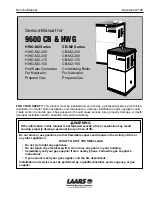
9600 CB & HWG Service Manual
Page 13
Boiling noises can occur because of air in the
secondary loop of a heating system (9600 CB
applications) or because of pump failures in either the
9600 CB or 9600 HWG.
Another boiling noise which occurs primarily on
9600 HWG units can result from liming of the primary
heat exchanger. This noise is more pronounced and
may occur at any temperature. If the pump appears to
be operating properly and the unit continues to run
normally except for the knocking sound then liming
should be suspected and the unit should be de-limed
according to the “Routine De-liming Procedure”. If the
knocking is very sever, de-liming may not stop the
noise and the primary heat exchanger will need to be
replaced.
The knocking sound may also exist on 9600 CB
and 9600 HWG units for a very short time followed by
a safety limit trip out. The generally results from total
pump failure (impeller sheared off or motor not
running at all).
1V. Short Cycling
There are two different types of short cycling
1.
System related
2.
Combustion related
The most common cause of system related short
cycling is boiler oversizing (9600 CB). Because the
9600 CB is a low mass boiler with high output it will
short cycle if system load or water flow are insufficient
to accept all of its output. This situation may also
occur with a properly sized boiler when it is installed in
a zoned system and one or more of the zones are very
small. If a small zone causes the problem then it may
be necessary to only allow that zone to
operate when another zone is calling.
This can be accomplished without
repiping in a zone valve system by disconnection the
end switch wire from
the zone valve which controls the small zone(s). If the
boiler is oversized, cycle
time may be reduced by reducing the
boiler input. An orifice kit is available to reduce input
from 200,00 BTU/HR to 150,000 BTU/HR or
175,000 BTU/HR.
System related short cycling can also occur on
9600 HWG Units. It results from very high aquastat
settings on the storage tank. Settings higher than 160°-
170°F (71°-77°C) should be suspected of being the
cause. Many times tank aquastats are set high to
compensate for an undersized system. If they are set
too high and the unit short cycles then the output from
the system will actually be reduced.
Combustion related short cycling occurs when the
burner is incorrectly adjusted. Lean mixtures (low
CO2 or high O2) cause the boiler control to lose the
flame signal. The control then causes a restart and if
the flame signal is sensed on the restart then the
burner will operate again. The intermittent sending and
losing of the flame signal by the boiler control causes it
to short cycle the burner. If combustion related short
cycling is suspected refer to “Checking Combustion”.
1W. Lock Outs (& Trip Outs)
The principal cause of nuisance lockouts are
1.
moisture in the combustion chamber
2.
poor combustion
3.
igniter failure
4.
short cycling
Safety limit trip outs are generally caused by low
flow or recirculation in the primary heat exchanger.
Moisture in the combustion chamber can be
caused by a failure of the thermostatic element in the
diverting valve. If the element fails in the full open
position, it will cause the primary heat exchanger to
operate in the condensing mode by allowing low outlet
temperatures. This condition should be suspected if
boiler outlet temperatures are consistently below 160°F
(71°C). The moisture causes a loss in flame sensing
and the boiler control will shut the unit down.
Poor combustion may cause a boiler control
lockout by transmitting a very weak flame signal to the
boiler control. The boiler control senses a flame using
the flame recertification principle. This principle
utilizes the fact that a flame is not only conductive but
it converts AC voltages to DC. The igniter which
becomes a flame sensor after it is deenergized as an
igniter has an AC voltage applied to it by the control.
If a flame exists the AC is converted to DC and
conducted to ground through the burner or the primary
heat exchanger.
Since natural gas or LP are neither conductive
nor capable or rectifying an AC voltage to DC, the
burner control can determine if a flame exists or not by
the presence of DC or AC current. Poor combustion
can make this decision difficult because of poor
conductivity. There are many causes for poor
combustion. Incorrect burner adjustment is the most
obvious, however, a blocked condensate drain or an
improper flue installation can cause a restriction in the
flue which will cause poor combustion. If there is a
restriction in the flue from condensate or rain water
buildup a gurgling sound can be heard at the vent
terminal.
Igniter failure may also cause a nuisance lockout
but not very often. If igniter failure is the cause there
probably will be an indication of overheating in the
igniter area resulting from gasket failure.
Short cycling may cause either burner control
lockouts or tripouts of the manual reset safety limit.
Generally it will be tripouts, however, in some
instances a lockout will occur and the boiler control










































